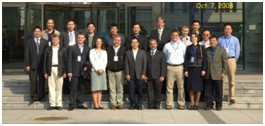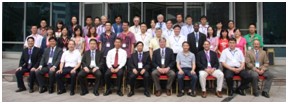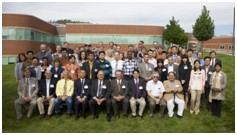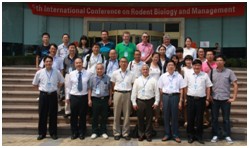|
No. |
Name of conference |
Date |
City |
|
1 |
The 1st Workshop on Regional Surveillance and Research for Wildlife-Borne Diseases |
October, 2008 |
Beijing, China |
|
|
|
|
|
|
2 |
The 2nd Workshop on Regional Surveillance and Research for Wildlife-Borne Diseases |
July,2009 |
Beijing, China |
|
|
|
|
|
|
3 |
The 3rd Workshop on Regional Surveillance and Research for Wildlife-Borne Diseases |
July,2010 |
Beijing, China |
|
|
|
|
|
|
4 |
The 4th Workshop on Regional Surveillance and Research for Wildlife-Borne Diseases |
August,2011 |
Beijing, China |
|
|
|
|
|
|
5 |
The 5th Workshop on Regional Surveillance and Research for Wildlife-Borne Diseases |
July,2012 |
Suzhou, China |
|
|
|
|
|
|
6 |
The 6th Workshop on Regional Surveillance and Research for Wildlife-Borne Diseases |
August,2013 |
Fort Collins, Colorado, America |
|
|
|
|
|
|
7 |
The 7th Workshop on Regional Surveillance and Research for Wildlife-Borne Diseases |
July,2014 |
Zhengzhou, China |
|
|
|
|
|
2. Asia-Pacific Wildlife Diseases Network
Wildlife species are important components in disease transmission and persistence. They serve a critical role when viewing disease from a One Health perspective. Although often misunderstood or underestimated, disease issues within wildlife species could greatly impact concerns in domestic animal or human health. Recent outbreaks of some zoonotic diseases can be traced, at least in part, to wildlife species. Beyond the potential threat to humans and agricultural resources, wildlife diseases also threaten biodiversity and animal welfare within natural ecosystems. Pathogens carried by wildlife species are extremely complex. Wild animals exist in varied habitats, covering most of the globe and climatic conditions. The diversity of species and habitats renders a plethora of conditions for natural pathogens, such as parasites, bacteria and viruses. Scientific data show that many animal and human diseases, such as AIDS, high pathogenic avian influenza, Newcastle disease, plague, rabies, monkey pox and West Nile fever, were initially derived from wild animals, and that wildlife species serve as intermediate hosts, or vectors, or contribute some medium to a pathogen’s life cycle.
Wildlife species are active in almost every environment and there is significant potential for interaction with domestic species. Backyard farms enable considerable encounters among wild and domestic animals. Even biosecurity facilities can have rodent problems and small wild birds are difficult to eliminate completely. Whether these species can serve as bridge species to transmit diseases into facilities or as hosts to enable pathogens to persist is often unknown and frequently not investigated. Seasonal migrations of many mammal species or natural dispersals can spread disease significant distances. Migrations can range for thousands of kilometers, crossing many countries and covering multiple continents. These movements are only rudimentarily understood and impossible to control. Wildlife disease infection and transmission occurs on a global scale, ignorant of borders. Pathogens in migratory species can pose risks across continents. Thus, increased cooperation among countries would benefit the knowledge of potential threats and improve response capacity. Sharing disease-monitoring networks to facilitate information exchange about emerging epidemics would benefit preparation efforts and enable neighboring partners to coordinate control tactics. When shared, the expertise or resources acquired in one country can improve response capacity of the global community. Collective knowledge gained through research or surveillance activities can greatly enhance the global intellectual capacity to understand and develop responses to emerging wildlife disease issues.
The need for countries to work together is an important aspect to address emerging wildlife disease issues. Equally important is the capacity for individuals to share ideas and information. In this regards, the Bilateral Working Group formed by the United States Department of Agriculture, Animal and Plant Health Inspection Service, Wildlife Services (USDA-WS) and the Chinese Academy of Sciences, Bureau of Life Sciences and Biotechnology (CAS-BLSB) is creating a communication network to enable scientists and managers working on wildlife diseases to share ideas and ask questions among their peers. Joining the network does not obligate any individual or country to share data, but rather provides the opportunity to communicate with other persons addressing similar issues. Hopefully dialogue started during regional conferences or workshops can be continued beyond that shared during meetings. Overtime, the network could serve to identify training needs or potential workshops. The intent would be as future conferences are developed a greater audience may provide guidance and insight as to who should participate and topics to be addressed.
Goal: Develop a communication network for exchange of ideas and information among persons working on wildlife disease issues.
Objectives:
1) Facilitate information exchange among persons across countries and disciplines working on wildlife disease issues;
2) Bring together wildlife biologists, veterinarians and other individuals to coordinate and collaborate on wildlife borne disease issues;
3) Increase understanding and awareness of threats posed by emerging wildlife diseases to agriculture, natural resources and human health;
4) Serve to identify training and workshop needs to promote capacity to address wildlife borne disease issues;
5) Increase cooperation and collaboration among agencies, scientific institutions and non-government organizations to develop activities that address wildlife borne disease concerns.
Target Audience: Individuals working on or concerned about wildlife borne diseases and related threats posed to agricultural, natural resources, and human health.
Principle Language: English
Sponsor: Bi-Lateral Working Group formed by CAS-BSLB and USDA-WS
Operation: The network will be operated by the secretariat office, which will be housed in the Institute of Zoology, Chinese Academy of Sciences.
Initial Contact Persons:
Dale Nolte National Wildlife Disease Program, USDA/APHIS/Wildlife Services
Hongxuan He National Research Center for Wildlife Borne Disease, CAS/Institute of Zoology








